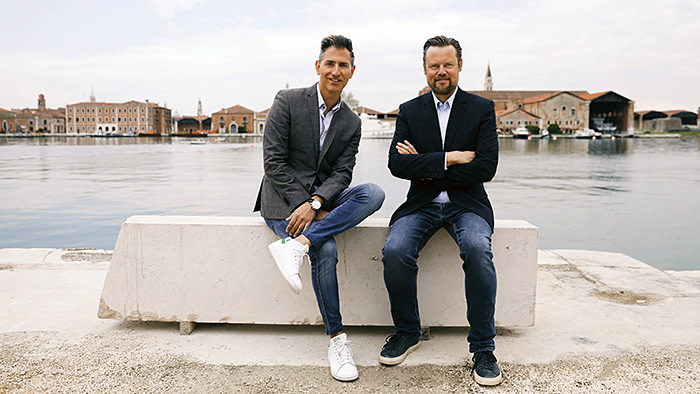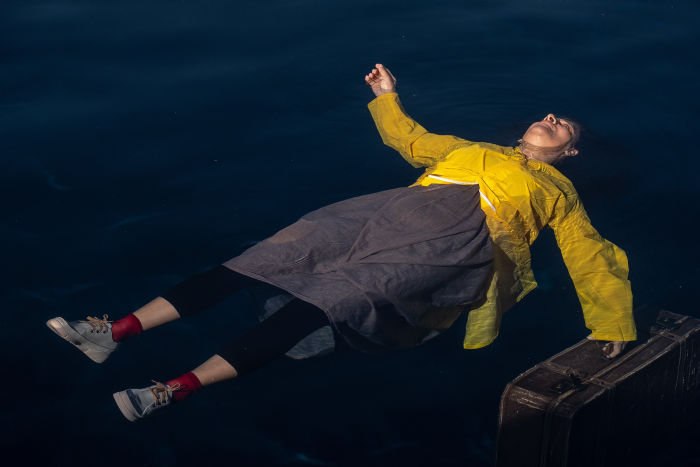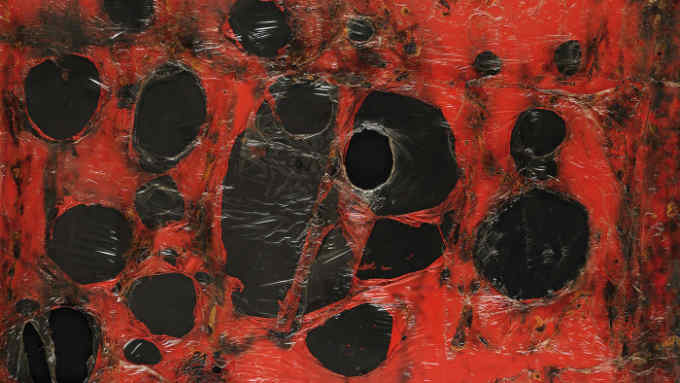How the curators of Venice’s UAE pavilion are reorientating the past

Roula Khalaf, Editor of the FT, selects her favourite stories in this weekly newsletter.
As Sam Bardaouil and Till Fellrath lead me across a green canal into the Venice Arsenale, past the endless shipyards and warehouses within its fortress-like walls, they exclaim at the war machine fed by such an arsenal — a word derived from the Arabic dar as-sina’ah, used by the Venetian empire.
An eye for history and its cross-currents is not surprising in this curatorial duo. Their sleuth-like recovery of misunderstood 20th-century modernisms ranges from Lebanon and Egypt to the Korean peninsula. “We don’t just look at contemporary art but mix it up,” Fellrath says, “giving a current look at art made over a longer period.”
They are in Venice installing “Passage”, a video piece by the Emirati poet and film-maker Nujoom Alghanem, in the UAE Pavilion. Shot in Venice and the Arabian peninsula, the video’s two channels are projected on opposite sides of a giant screen, sharing a soundtrack. A Syrian actor living in the UAE plays a woman displaced. The flip side is a video journal of the poet. The piece partly reflects the importance of poetry in the Arab world, Bardaouil says. “Slandering someone in a poem could start a war; a poet’s praise could bring peace.”
National pavilions might seem at odds with the duo’s “transcultural” approach. Yet for Bardaouil, “it’s not about representing a nation or competing.” Their 2013 Lebanon Pavilion caused a stir with Akram Zaatari’s “Letter to a Refusing Pilot”, about an Israeli airman. “It raised the question,” Bardaouil says, “in war, could there be good people on the other side of the border?” Alghanem’s work “captures anxiety about rapid modernisation, and how to maintain your values with an influx from the world.” A live issue in the UAE, it also “resonates in Italy, with [the nationalist deputy prime minister Matteo] Salvini”.
Art Reoriented, the independent curatorial platform Bardaouil and Fellrath co-founded in New York and Munich, is marking 10 years of groundbreaking shows. These range from I Spy With My Little Eye , on a new generation of Beirut-based artists, to Art et Liberté , on the surrealist movement in 1940s Cairo. Since that show — which went from the Pompidou Centre in Paris in 2016 to Reina Sofia in Madrid and Tate Liverpool — Bardaouil says: “Museums are buying Egyptian pieces for inclusion in permanent Surrealism collections.” His book Surrealism in Egypt involved the kind of detective work that does not simply plug gaps but reorients art history. For Bardaouil, “it’s [about] changing people’s points of reference, imagining a new canon”.

These curators are intent on dissolving “rigid labels of geography, period and style”. They favour the term “transmodernity”. For Bardaouil, “the history of modernity is so intertwined with the history of displacement”. An artist’s background “marks them but shouldn’t niche or frame them. We don’t talk about ‘Arab art’ but art from the Arab world.”
Art Reoriented was formed in 2009, partly to re-engage audiences beyond critics (“ ‘artspeak’ has been very detrimental”, Fellrath tells me). Their most recent show, Ways of Seeing, paid homage to the late critic John Berger and his 1970s BBC TV series directed by Mike Dibb. “It felt so visionary,” says Bardaouil. “Before Edward Said, Berger opened up important discussions about post-colonialism.” Their show changed with each location, from Istanbul to NYU Abu Dhabi. It was conceived when the political climate in Turkey “was getting difficult for artists”, Bardaouil adds, as “an art-centred way to show the importance of different points of view, not just one way of seeing.” The catalogue-cover mirror is a reminder that the viewer, imbued with assumptions, completes the art work.
Bardaouil attributes a “sensitivity to space, framing, storytelling and light, moments of conflict and anticipation”, to his early work in theatre. Born in Beirut just before the civil war of 1975-90, he says his parents were “adamant about not leaving. I’m so happy because you learn empathy despite people killing each other. We were Christian — it wasn’t an issue. Muslim friends on the other side of the Green Line risked their lives to bring us food and medicine, and we did the same.” After the war, he spent six years in Britain, studying art history, theology (“because the so-called cause of the war was religion”) and acting. Following teaching in Beirut and Dubai, he moved to New York in 2007.
There he met Fellrath, also an art-world outsider. He was born near Düsseldorf, but his father’s work in the automobile industry took the family to Iraq, Saudi Arabia, Syria, Lebanon and Sudan. He studied economics before teaching at the LSE in London, and finds an economics background useful, less for the art market (“we don’t get involved in auctions”) than for “understanding how the world connects. It helps you look for structure and ask the right questions about how societies work.”
On working with Middle East institutions, Bardaouil says: “In the civil war I learnt that if you insist on bulldozing with your own opinion, the end is never good. I don’t want to parachute into a place and bring in values as aggressively as the US military bringing democracy to Iraq. You push boundaries in a way that never breaks the bridge.
“You can’t study curation,” he adds, before they return to work in the Arsenale. “It’s an innate talent, an art form. Sitting with an artist in a true dialogue, that’s when the magic begins.”
Follow @FTLifeArts on Twitter to find out about our latest stories first. Subscribe to FT Life on YouTube for the latest FT Weekend videos

Comments